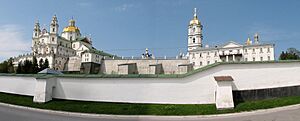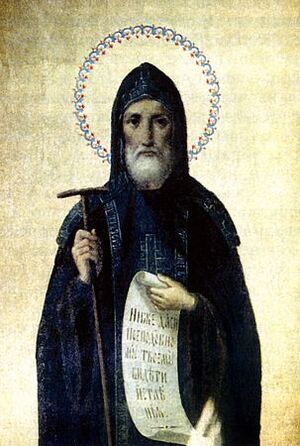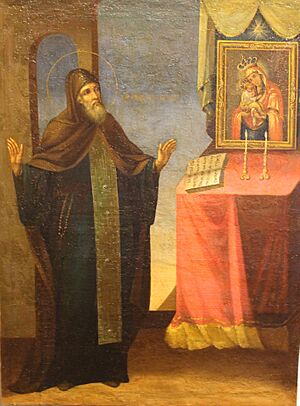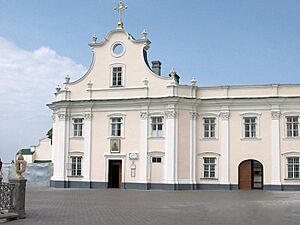Job of Pochayev facts for kids
Quick facts for kids SaintJob of Pochayev |
|
|---|---|
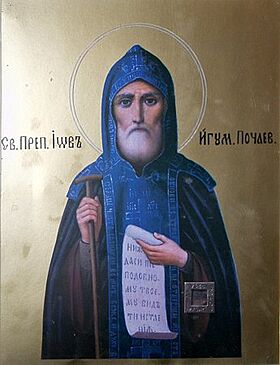
|
|
| Hegumen | |
| Born | c. 1551 near Kolomyia, Ruthenian Voivodeship |
| Died | 28 October 1651 Pochayiv, Volhynian Voivodeship |
| Venerated in | Eastern Orthodox Church |
| Major shrine | Pochayev Lavra |
| Feast | October 10 (Synaxis) October 28 (Repose) May 6 (Feast day) August 28 (Uncovering of Relics) |
| Attributes | Vested as a monk, holding an abbot's crozier |
Saint Job of Pochayev (born around 1551 – died October 28, 1651) was an important Eastern Orthodox monk and saint. His birth name was Ivan Zalizo. Later, when he became a monk, he was called Job. When he took a special vow called the Great Schema, he was given the name John.
Contents
Early Life and Becoming a Monk
Ivan's Childhood Years
Job was born around 1551 near the city of Kolomyia in a region called Galicia. At that time, this area was part of the Polish kingdom.
His parents, John and Agapia, were very religious. They named him Ivan (which is like John) after John the Baptist. Ivan's family name, Zalizo, means "Iron."
Young Ivan looked up to saints like Rastko Nemanjić and John of Damascus. He also studied a book called "The Ladder" by John Climacus. These stories helped him learn how to live a good and virtuous life.
Joining the Monastery
When Ivan was just 10 years old, he secretly left his home. He went to the Transfiguration Ugorniki Monastery. He asked the hegumen (the head of the monastery, like an abbot) if he could join and serve the monks.
At age 12, Ivan became a monk. This special ceremony is called a tonsure. He was given the new name Job. From that day on, he tried to live like the biblical character Job, who was known for his patience and faith. When he turned 31, he became a priest.
Serving and Writing for His Faith
Moving to Dubno Monastery
A powerful leader named Konstantin Ostrozhsky was a strong supporter of the Orthodox faith. He asked Job many times to move to another monastery.
So, Job moved to the Exaltation of the Cross monastery near Dubno. This monastery followed strict rules, similar to those set by Theodore the Studite. For 20 years, Job served as the hegumen (abbot) there.
Job's Important Writings
During his time at Dubno, Job spent a lot of time writing religious books. His most famous collection of works is called The Book of the Venerable Job of Pochayiv, Written by His Own Hand.
This book contained 80 of his teachings, talks, and sermons. It also included parts he copied from the writings of other Holy Fathers (important early Christian writers). Later, this book was translated into Russian and published again in 1881. It was called Pchela Pochayevskaya, which means The Bee of Pochayiv.
Defending the Orthodox Faith
In his writings, Job strongly defended the Orthodox Church. He wrote against different Protestant beliefs that were spreading in his region. He explained important Orthodox teachings, like the Trinity (God as Father, Son, and Holy Spirit). He also wrote about the divinity of Christ (that Jesus is God) and the Mother of God (Mary).
Job also disagreed with some teachings of the Roman Catholic Church. For example, he wrote about their use of azymes (unleavened bread) in the Eucharist (Holy Communion).
After the Union of Brest in 1596, many Orthodox Christians in Poland faced difficulties. They lost some of their rights, and some were pressured to become Catholic. To fight this, Job and others copied and shared Orthodox books. Prince Ostrozhsky also helped by printing the Ostrog Bible in 1581. This was the first complete Orthodox Bible ever printed.
Life as a Hermit in Pochayev
Becoming a Hermit
As Job became more famous, he decided to live a simpler life. He chose to become a hermit. This means living alone, away from others, often for religious reasons.
He moved to the caves monastery at Pochayev in 1604. A lavra is a very large and important monastery. Eventually, Job was chosen to be the hegumen (abbot) there too.
Life in the Cave
Job was known for being quiet and speaking only a few words. The only sound often heard from him was the Jesus prayer. For many days and weeks, he would stay in his locked cave.
This cave was so small that it was hard to sit, stand, or lie down comfortably. From kneeling for long hours, his knees became sore. He even wore marks into the rock floor of the cave.
His student, Dosyfey, once saw a bright, glowing light coming from Job's cave. This light, like the Light of Tabor mentioned in the Bible, shone for two hours. Dosyfey was very scared and fell to the ground.
Monastery Challenges
Job brought strict rules and improvements to the monastery. During his time, the monastery faced many problems. A man named Andrzej Firlej often attacked the monks. He sued them over land and a special icon of the Mother of God that his grandmother had given to the monastery.
In 1623, Firlej even raided the monastery and took the holy icon. He kept it until 1641, when a court finally ordered him to return it to the monks.
In 1628, Job attended an important meeting in Kiev called the Synod. This meeting was held to defend the Orthodox Church against the movement called Uniatism.
Sometime after 1642, Job took a special monastic vow called the Great Schema. He received a new monastic name, John.
Death and Becoming a Saint
Job passed away on October 25, 1651. He was recognized as a saint soon after his death. This process is called glorification.
After Job died, he appeared three times in a vision to Dionysius Balaban. Dionysius was the Metropolitan of Kiev, a very important church leader. In these visions, Job told him that God wanted him to uncover the saint's relics. Relics are the remains of a saint, often their body or personal items.
At first, Metropolitan Dionysius did not follow the instructions. But after the third vision, Job warned him of trouble if he kept disobeying. So, Dionysius understood it was God's will.
On August 28, 1659, the Metropolitan went to Pochayev. He ordered Job's grave to be opened right away. His body was found to be incorrupt, meaning it had not decayed. It also had a wonderful, sweet smell. The relics were then moved to the Trinity Cathedral of the Lavra. People came to honor them.
Another "Uncovering of the Relics" happened on August 28, 1833. Job's relics were formally moved to a church built in his honor at the Pochayev Lavra.
Every year, on August 28, many Orthodox pilgrims visit Pochayev Lavra. They come to honor Saint Job, pray near his relics, and ask for his intercession (his prayers on their behalf).
Miracles and Special Events
Defending the Monastery
During the Zbarazh War in 1675, the monastery was attacked by the Turks. It is said that the Turks ran away when they saw a vision of the Theotokos (the Mother of God) with angels and Saint Job.
Many Turkish Muslims who saw this during the attack later became Christians. One of the monastery's chapels remembers this amazing event.
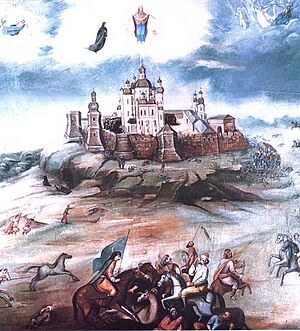
Count Potocki's Story
In 1759, a carriage belonging to Count Mikołaj Bazyli Potocki overturned near the monastery. In anger, Potocki shot at his driver three times, but none of the shots hit him.
Potocki believed this was a miracle from God. He then moved to Pochayiv and gave many gifts to the monastery. In 1773, Potocki, who was Catholic, asked the Pope to say that the Pochayev icon was miraculous and that Job was a Catholic saint. Only the first request was granted.
Later Visions
On October 28, 1908, during a celebration of Saint Job's feast day, Job appeared in a vision. He appeared to the Bishop of Volhynia and blessed the Holy Mysteries (the Body and Blood of Christ).
The cave church of St. Job has a famous silver container for his relics. This was a gift from Countess Orlova.
A printing press called "The Printshop of St. Job of Pochaev" is located at Holy Trinity Monastery in Jordanville, New York. It is named after Saint Job and prints religious books.
Feast Days
The Eastern Orthodox Church celebrates the memory of Saint Job on October 28. This is the day he passed away. (For churches that use the Julian Calendar, October 28 falls on November 10 of the Gregorian Calendar, which is 13 days later).
On August 28 (or September 10 on the Gregorian Calendar), the church celebrates the day his relics were uncovered. In 1902, the Holy Synod decided that on this day, Job's holy relics should be carried in a crucession (a religious procession) around the Dormition Cathedral after the Divine Liturgy (church service).
He is also remembered on October 10 (or October 23 on the Gregorian Calendar). This is because he is one of seven saints honored on the Synaxis of the Saints of Volhynia.
See also
- Pochayiv Lavra


